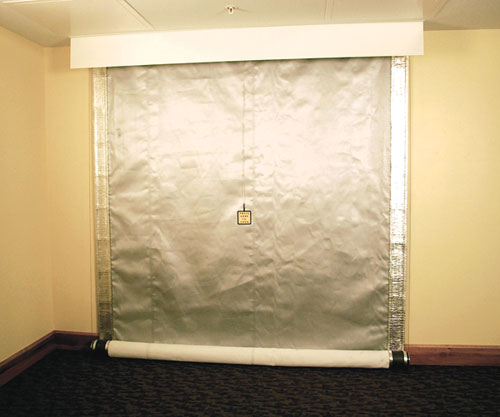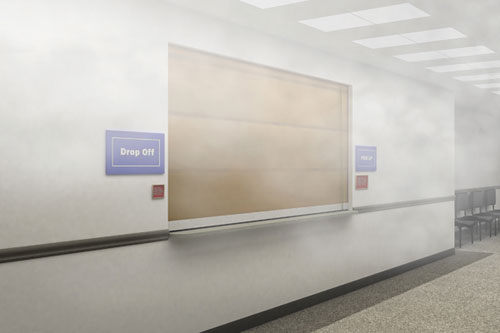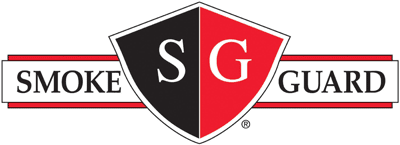Design Alternatives to the Enclosed Elevator Lobby: Fire and Smoke Safety Solutions
Countertops in Fire or Smoke Rated Walls
There are many instances, in different types of buildings, where a fire-rated or smoke-rated wall has been structurally modified to provide a counter space between two different areas. Examples include pharmacy dispensary areas in hospitals, business reception areas, higher education administration areas, and expediting areas linking kitchens and dining rooms. The creation of a counter space means that the wall now only partially separates the two areas, instead of providing complete fire or smoke separation as required. In order to have a countertop opening in a fire-rated or smoke-rated wall, the IBC requires the rating of the wall be maintained by specifying an appropriate fire or smoke-rated assembly in the opening that can be closed in case an emergency occurs. Rolling steel doors and smoke curtain systems are two popular assemblies used to maintain the integrity of the barrier.
Rolling Steel Doors
Steel roll-down doors are the traditional solution chosen by architects to complete the fire-and-smoke-rated walls in countertop situations. In some instances, the countertop pass through must be able to be closed and locked. Steel roll-down doors provide a doubleduty solution, because they are able to meet both the life safety and security barrier requirements.
 |
A fire-and-smoke-rated rolling magnetic gasketing system provides the required smoke and fire-rated barrier necessary to protect an area of refuge. Photo courtesy of Smoke Guard, Inc. |
Â
Smoke Curtain Systems
A new solution for a code-mandated countertop assembly is a smoke curtain system. Smoke curtain systems use a smoke-rated fabric and side guides to create a high-performance smoke barrier that will resist air leakage. The curtains are mounted above the ceiling and deploy when local smoke detectors sense smoke.
Solution Comparisons
Steel doors are typically bulky and heavy. Smoke curtains are significantly lighter solutions, adding between 60 and 150 pounds at each countertop application. While both solutions are excellent smoke and fire barriers, rolling steel doors can represent a different type of health hazard to human occupants, because the heavy doors can deploy inadvertently. Staff members behind the counter often block the rolling steel door open to protect themselves and patients or customers. Additionally, when the doors do deploy, they often require that a company technician visit the building and reset the door to ensure that the trigger mechanism is properly in place again. Smoke curtain systems can be easily rewound by a facility manager and do not require any third party expertise for maintenance.
 |
Smoke curtain systems provide an alternative solution to the rolling steel doors often specified to complete countertop enclosures in fire or smoke-rated walls. Photo courtesy of Smoke Guard, Inc. |
Â
Atriums
While atriums are often designed into multi-story buildings to open up the space and provide building occupants with more access to natural light, these central spaces have been recognized as a weak point in building fire safety, because they allow fire and smoke to spread to the upper stories of a building more quickly.
Depending upon the size of the atrium, stack effect can occur, naturally drawing smoke into the atrium and up through the building. In an outdoor environment, this would provide a natural mode of egress for the smoke, but in a building the smoke and soot will collect at the ceiling or roof and fall back down into the interior, occupied spaces. Building occupants on every level of the atrium need to be protected from fire and smoke, so that they can safely move away from the atrium to the emergency exits in the building.
In order to provide this protection, the IBC mandates the inclusion of two safety systems in an atrium: a smoke control system to help ventilate the area and a one hour rated fire barrier on every floor to separate the atrium from the rest of the building. The smoke control system can be either active, using fans, or passive, employing louvers or vents, to manage the smoke in the space. Use of a smoke control system also allows the designer to leave as many as three floors open to the atrium space as long as the design of the smoke control system takes this added space into account. The fire barriers and opening protectives on each floor also help to contain the smoke in the area of origination, whether that is on a floor or in the atrium, and minimize the areas of the building that will incur smoke damage. The barriers also eliminate smoke migration and protect people on non-fire floors from hazardous smoke exposure.
Healthcare Facilities and Prisons
IBC code specifies that buildings equipped with automatic sprinklers are exempt from the enclosed elevator lobby requirement, with the exception of high-rise buildings, healthcare facilities, and prisons or confinement facilities. Healthcare facilities and prisons are also required to incorporate two or more smoke compartments on each floor. These extra code requirements are in place because the institutional tenants found in healthcare facilities and prisons are not free to evacuate. Staff in these institutions must execute a defend-in-place strategy when a fire occurs using sprinklers, fire extinguishers, and smoke compartments. A smoke compartment is essentially a six-sided box encased by walls constructed as smoke barriers with a minimum of a one-hour fire rating and with opening protectives that are rated in accordance with UL 1784.
Thinking Outside the Box
Architects today have a variety of code-compliant solutions that will protect building occupants from fire and smoke and, simultaneously, eliminate the traditional, and space-eating, enclosed elevator lobbies from the floorplan. Each of these new solutions offers unique benefits to the building in terms of air leakage performance, maintenance costs, and overall costs to the project providing protection that is equal to or superior to the standard vestibule approach. When it comes to specifying fire and smoke safety throughout a multi-story project, healthcare facility, or prison, there are many benefits to thinking and designing outside of the box.
Â
|









